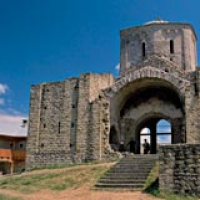Đurđevi Stupovi
Đurđevi Stupovi
The Monastery is near Novi Pazar, on top of a cone-like elevation, a rare position in the Serbian Medieval Art for a monastery being on a prominent place.
The building of the Monastery started, most probably, in 1167, and it was found (according to the endower's inscription on the western portal of the church) that the works were completed in 1170/71. It was commission by Stefan Nemanja, who dedicated the church to St. George, for having him out of dungeons-caves where his brothers shut him. Following that conflict with his brothers, Stefan Nemanja took over the power of the Grand Zupan of Raška.
Uniquely, the staircase leads to the western entrance, because of the position of the church. Craftsmen from the coastlands have brought along their Romanesque skills. Characteristic of the Romanesque style are two domes included in the plan of the church, situated in the west, to the left and right from the narthex. The plan and spatial layout of the church, portals and stylistic finishing were done in the Romanesque spirit.
UNESCO included the Djurdjevi Stupovi in the World Art Heritage.


Comments
Leave a comment